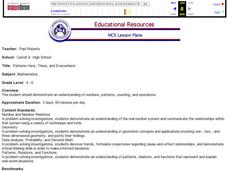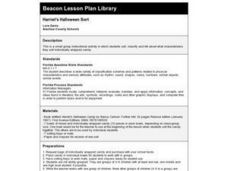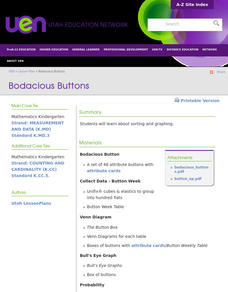Curated OER
Fish Eyes Sort
Students sort, classify and write about what characteristics they used to sort fish counters.
Curated OER
Sorting Through Life!
Students sort and count objects. In this sorting skills instructional activity, students work in small group with various objects that can be sorted and counted in groups.
Curated OER
Patterns Here, There and Everywhere
Pattern recognition is a skill often used in mathematics. Learners count and sort manipulatives, organize the data into a graph and answer questions about the information displayed. They collect the objects to be used and create patterns...
Curated OER
All Sorts of Seeds!
First graders compare seeds and explore how they are carried through the environment.
Curated OER
Sorting
Students sort a variety of manipulatives and use a software program that provides more sorting practice.
Curated OER
Seeds in Fall...Collect Them All!
Classify seeds by attributes such as size, shape and color! Learners classify seeds using a dichotomous key. They identify human behaviors that have a positive impact on preserving seed and plant biodiversity.
Curated OER
Can You Name That Shape?
Learners use materials to build, investigate, and draw two-dimensional shapes (polygons). They combine the shapes they have built and draw from the pile to begin a round-robin activity to name and determine the attributes of a selection...
EngageNY
Arithmetic and Geometric Sequences
Arithmetic and geometric sequences are linear and geometric patterns. Help pupils understand the relationship and see the connection with an activity that asks them to write the rules and classify the patterns correctly. A sorting...
Curated OER
Sorting Objects
First graders experiment with sorting. In this sorting lesson, 1st graders separate objects according to one attribute: smooth, rough, hard or soft.
Pennsylvania Department of Education
Sorting Buttons
Students demonstrate how to sort buttons by attributes. In this classification lesson, students are given buttons and are asked to sort them independently by their attributes. Additionally, students are given one extra button after they...
Curated OER
Harriet's Halloween Sort
Students listen to the book, Harriet's Halloween Candy, and discuss the many ways Harriet sorted the candy from her trick-or-treat bag. They sort and classify individually wrapped candy.
Curated OER
Investigation: Sorting and Classifying
Fifth graders explore geometry by creating shapes with construction paper. For this shape characteristics lesson, 5th graders identify the different attributes that make up specific shapes and create them using construction paper,...
Curated OER
Bodacious Buttons
First graders participate in games, graphing, and probability exercises to sort and graph buttons. They sort buttons with Venn diagrams and Bull's Eye graphs.
Curated OER
What is a bird?
Students sort birds by their physical characteristics. In this bird characteristics lesson, students review bird characteristics and create beaks. Students discuss birds as pets.
Curated OER
Investigation: Reasoning and Proof
Students explore animal characteristics by creating illustrations. In this animal identification lesson, students read a list of animal descriptions which they draw using crayons or colored pencils. Students view their drawings and...
Curated OER
An Introduction to Acids and Bases
Young scholars explore acids and bases. In this lesson about acids and bases, students do an experiment to test certain items to determine what they are. Young scholars use cabbage and litmus paper as indicators. Students understand how...
Curated OER
Animal Coverings
Students read a book. In this animal characteristics lesson, students read the book Animal Coverings, answer comprehension questions, and complete a chart where they match animals with their coverings.
Curated OER
Quadrilaterals
Students create, classify and sort quadrilaterals. They create several four-sided polygons, then choose their most unique quadrilateral to share with their group.
Curated OER
Decidedly Different
Fifth graders inquire as to why scientists use observable characteristics, how they sort the characteristics, and why they do so. They write journal entries to be used throughout this unit.
Curated OER
What's in the Bag?
Help your students identify the attributes of two-dimensional shapes. They read the book Round is a Mooncake, and use pattern blocks to sort shapes. Students sort shapes according to their attributes.
EngageNY
Close Reading of The Boy Who Loved Words: How Do People Build Their Word Power?
Third graders practice the skills of identifying the main message in a story, describing the main character, and sorting the key details of a story into specific categories. The story they read is, The Boy Who Loved Words. Using a...
EngageNY
Structuring The Search: Categorizing Our Research
What can you contribute? Scholars read text to determine how ants contribute to the rainforest. First, they categorize and sort facts gathered from reading. Next, readers focus on specific terms in each paragraphs of the text Ants by...
Curated OER
Sorting Polygons
Tenth graders identify and classify polygons according to various attributes. In this sorting polygons lesson plan, 10th graders describe, classify and comprehend relationships among types of two-dimensional objects using their defining...
Curated OER
3-D Attributes
Learners explore geometric solids. In this geometry activity, students listen to the book The Greedy Triangle by Marilyn Burns, then work in groups to sort geometric solids into various categories. Learners define geometric solids...
Other popular searches
- Sorting Attributes by Color
- Science Sorting Attributes
- Sorting Attributes by Size
- Sorting Attributes by Weight
- Sorting Attributes Pre K
- Sorting Attributes Prue K
- Sorting Attributes Venn

























